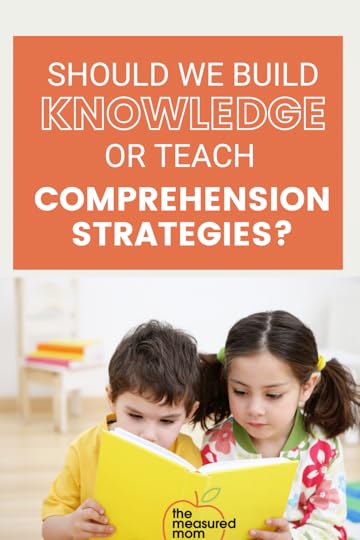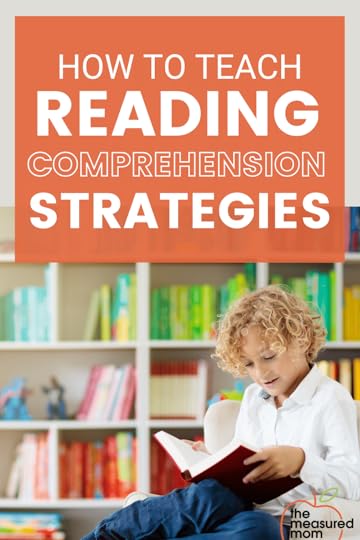Should we build knowledge or teach reading comprehension strategies?

A current debate in the science of reading community is whether teachers should build knowledge or teach reading comprehension strategies. In today’s post I’ll explain why both are necessary.
What’s the science of reading?But first … what’s the “science of reading,” anyway? Five years ago, most teachers had never even heard the term. Now it’s everywhere!
The science of reading is simply a body of scientifically-based research about reading. It’s not a fad, a pendulum swing, or a curriculum. It’s just a body of research.If you follow “science of reading” influencers on Instagram or Facebook, you’ll find that most of the conversation centers around phonics. Unfortunately, this has led many people to believe that the science of reading = phonics, which is simply not true.
The reason that much of the “science of reading” conversation centers around phonics instruction is that many balanced literacy approaches haven’t done a great job with it. We know from the National Reading Panel that phonics instruction should be systematic and explicit. But many balanced literacy programs do not follow a phonics scope and sequence. They often teach phonics implicitly or through very brief mini-lessons. And they have students practice using leveled, predictable texts which give them very little opportunity to apply their phonics knowledge.
Phonics instruction has gotten a lot of attention because it needs a lot of attention. It’s something many of us (I’m raising my hand here) needed to improve, and the way to do this is relatively straightforward.
The science of reading is more than phonicsBut there’s much more to the science of reading than phonics. A lot more. Such as vocabulary and comprehension.
Unlike phonics, which can be mastered in a few years, comprehension is much more complex. It’s an unconstrained skill – which means that it continues to grow over one’s lifetime.Because comprehension is so complex, it’s hard to pin down how to improve it. This makes the conversation a lot more nuanced.
Reading comprehension strategies … and what I got wrongReading comprehension strategies are are deliberate mental actions to improve comprehension (Shanahan et al, 2010).
[image error]A great deal of research has shown that instruction in these strategies improves understanding (National Reading Panel, 2000).
The problem is that many teachers (including yours truly) have gone about strategy instruction backward. I remember compiling lists of books that lent themselves to a particular strategy – books that would help kids practice predicting, making connections, or inferring. Then I would spend days or weeks teaching a particular strategy. My main focus wasn’t helping students learn from the text – instead, I focused on helping them master the strategy.
This was backward.
Instead of using the strategy as the starting point, I should have started with a quality text and then taught the strategies that would best help students understand it.
The importance of building knowledgeAccording to Daniel Willingham (2006b), “teaching reading strategies is a low-cost way to give developing readers a boost, but it should be a small part of a teacher’s job. Acquiring a broad vocabulary and a rich base of background knowledge will yield more substantial long-term benefits.”
If you’re wondering why we need to teach information in a world where search engines and Siri are right at our students’ fingertips, here’s the scoop:
Background knowledge helps readers make inferences. Inferences are conclusions we reach based on the information we have. We get this information from the text itself and from our background knowledge (Adams et al, 1995).Background knowledge gives us a place to attach new information. Marilyn Adams (2014) calls it “mental velcro.”
Background knowledge frees up space in working memory. If everything you’re reading is new information, it all takes up space in your working memory. Before long, you’ll reach cognitive overload and comprehension will suffer (Willingham, 2006a).
Because background knowledge frees up working memory, our brains are freed to think more deeply. Therefore, background knowledge improves critical thinking.
 Why reading comprehension strategies are still important
Why reading comprehension strategies are still importantKnowledge building is incredibly important, and I’m thankful for Natalie Wexler’s popular book The Knowledge Gap, which brought this to the forefront.
I also appreciate the work of the Knowledge Matters campaign and their accompanying podcast.
But I’ve seen an unintended side effect of their important work … the tossing out of reading comprehension strategies entirely.
It’s not that any of these experts would support that … in fact, Natalie Wexler (2023) wrote, “it’s not that there’s anything inherently wrong with teaching strategies. The problem is that American schools have gone way overboard on teaching them.”
We need to get the order right.
When we start with the text (and not the strategy), reading comprehension strategies are very useful tools for helping our students understand the content.When teaching a strategy, use what you know about explicit instruction.
Identify the strategy.Explain what it is.Stress how it will help students take conscious steps to better understand the text.As you read, think aloud by saying what you are thinking while you read.Guide your students in using the strategy.Eventually, have your students apply the strategy on their own.Always keep in mind the end goal – that students create a mental model – an overall representation of the meaning of the text. Strategies are only useful insofar as they help students understand and remember what they read.
This post is the beginning of a series about comprehension strategies. Just click on the image below so you can see all the posts as they are published!
 References
ReferencesAdams, B. C., Bell, L. C., & Perfetti, C. A. (1995). A trading relationship between reading skill and domain knowledge in children’s text comprehension. Discourse Processes, 20(3), 307-323.
Shanahan, T., Callison, K., Carriere, C., Duke, N. K., Pearson, P. D., Schatschneider, C., & Torgesen, J. (2010). Improving Reading Comprehension in Kindergarten through 3rd Grade: IES Practice Guide. NCEE 2010-4038. What Works Clearinghouse.
National Reading Panel (U.S.) & National Institute of Child Health and Human Development (U.S.). (2000). Report of the National Reading Panel: Teaching children to read: An evidence-based assessment of the scientific research literature on reading and its implications for reading instruction. U.S. Dept. of Health and Human Services, Public Health Service, National Institutes of Health, National Institute of Child Health and Human Development.
Wexler, N. (2023, July 5). No, teachers don’t have to choose between knowledge and strategies. Forbes. https://www.forbes.com/sites/nataliew...
Willingham, D. T. (2006). How knowledge helps. American Educator, 30(1), 30-37.
Willingham, D. T. (2006). The usefulness of brief instruction in reading comprehension strategies. American Educator, 30(4), 39-50.
Other resourcesTimothy Shanahan’s blog post (Shanahan on Literacy) – Knowledge or Comprehension Strategies – What Should We Teach? Joan Sedita’s blog post (Keys to Literacy) – Background Knowledge and Reading Comprehension Natalie Wexler’s book, The Knowledge Gap The Knowledge Matters podcastThe post Should we build knowledge or teach reading comprehension strategies? appeared first on The Measured Mom.
Anna Geiger's Blog
- Anna Geiger's profile
- 1 follower



